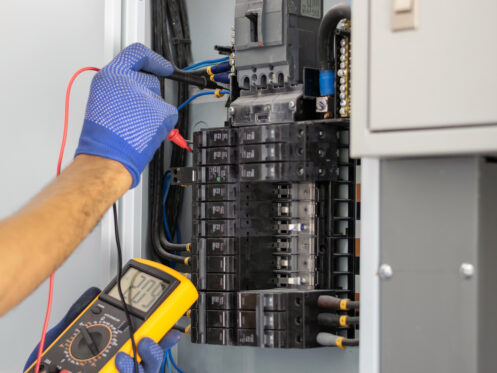The electrical panel is a vital component of an electrical system in any Kentucky, Indiana, or Ohio home. Not only is it what supplies power to every circuit, but it is also a safety measure that helps to protect against issues like electrical fires. The panel in your home must be in good condition and correctly sized. In this article, the team at Bryant Heating, Cooling, Plumbing & Electric discusses the signs that indicate you need to replace your electrical panel and other situations that warrant an upgrade.
1. Fuses Instead of Circuit Breakers
One sign that your electrical system is extremely out of date is if you have a fuse box instead of a breaker panel. Circuit breaker panels have been the standard since the 1960s. If your home has a fuse panel, you should consider having your electrical system rewired to ensure it is safe.
Circuit breakers and fuses immediately stop electricity from continuing to flow to a circuit if it gets overloaded or experiences a short circuit or arc fault. However, circuit breakers are much more reliable than fuses. Fuses don’t always blow if only a very minor overload occurs. This can be a safety hazard since an overload can cause electrical wiring to overheat and potentially start a fire. Circuit breakers are also far more convenient. They just need to be reset when they trip. With a fuse panel, you’ll need to replace the blown fuse before you can restore power to the circuit.
2. Panel Is Old or Damaged
Experts generally recommend that electrical panels be replaced after 25 to 40 years. If you know that your panel is older than this, it’s time to start thinking about an upgrade. If you’re unsure of how old your panel is, you may be able to determine its age by looking up the model number online or having an electrician inspect it.
We recommend having a full electrical safety inspection performed annually. This allows you to ensure that your electrical system is safe and free of any major issues. This inspection also makes it easier to determine when you need to upgrade your electrical panel.
Professional inspections are important, but it’s also a good idea to open the door to your electrical panel a few times a year to check for any visible issues. Specifically, you want to make sure that there are no rust, corrosion, or scorch marks on the panel. It shouldn’t feel hot or be making a humming or buzzing sound. Rust and corrosion can be serious issues since they can prevent circuit breakers from tripping when they should. Rust can also indicate that water has somehow gotten into the panel, which is another safety issue.
Scorching or burn marks indicate that a wire in the panel overheated. This can mean that the panel is at risk of catching fire. If you hear a humming or buzzing sound, it usually means that there is an overloaded circuit and the breaker won’t trip for some reason. Another possibility is that there is a loose wire or connection in the panel. These issues can sometimes be repaired without replacing the panel, but it depends on the overall condition and age of the panel.
3. Circuit Breakers Frequently Trip
It’s still important to have an electrician inspect a circuit if one breaker frequently trips. If multiple breakers in the panel trip regularly, you can suspect that the panel itself is the culprit. It likely needs to be repaired or replaced.

4. Amperage is Insufficient
Electrical issues aren’t the only reason why you may need to upgrade your electrical panel. Sometimes an upgrade is necessary simply because the panel isn’t large enough. It doesn’t supply enough power to meet all of your electrical needs.
The size of an electrical panel is measured in terms of how many amps it supplies. The National Electric Code requires every new home to have a 100-amp electrical panel. This requirement has been in place for all new homes since the 1990s. For larger homes or those with higher power needs, the requirement has been in place since at least the 1960s.
The issue is that many homes have much higher power needs than a 100-amp service panel can meet. This is why most newly built homes have at least 150-amp or 200-amp electrical service. With only a 100-amp panel, you are usually limited to no more than two or three 240-volt circuits. They may supply power to things like a central AC system, a hot tub, an electric water heater, or a clothes dryer. This means that it is often necessary to upgrade to a larger, higher-amperage panel if you want to install another 240-volt circuit for something. It may even be necessary if you want to install another 120-volt circuit for outdoor lighting or other uses. You may need to upgrade your panel when adding an addition to your home.
Before installing any new 120-volt or 240-volt circuit and wiring it into the electrical panel, an electrician will first perform an electrical load calculation. This involves adding up the total power draw of all the circuits and appliances in the home. This allows the electrician to determine if the existing panel has enough amperage to support the new circuit.
5. Panel Is Full
Even if your panel has sufficient amperage to support a new circuit, it may still need to be replaced. This may be because it is already full and has no room to install the new breaker for the circuit. If the panel does have sufficient amperage, you may be able to install a secondary sub-panel to accommodate the new circuit and breaker. However, we would recommend upgrading to a larger panel. Your power needs may increase in the future and lead to you having to switch to a larger panel at that point.
6. Flickering Lights
One final sign that you need to upgrade to a higher-amp electrical panel is if you notice your lights flicker and another electrical device in your home comes on. This can happen when starting the clothes dryer, when an electric water heater turns on, or when turning a vacuum on. Having lights in your home flicker in these situations is usually an indication that your electrical service doesn’t supply enough amperage. If the panel isn’t large enough, a high-power appliance can draw high levels of power, which leads to a temporary fluctuation or decrease in the power flowing to other circuits. This temporary power drop then causes the lights to flicker or dim.
Contact Bryant Heating, Cooling, Plumbing & Electric Today!
With more than 80 years of experience, Bryant Heating, Cooling, Plumbing & Electric is the company to trust if you need an electrical panel upgrade or any other electrical services in Kentucky, Indiana, or Ohio. We serve residents throughout the Louisville, Lexington, Cincinnati, Evansville, and Bowling Green areas. If you’re concerned that your electrical panel needs to be upgraded, /contact-us/ or call 844-216-9857 today to schedule an inspection.



